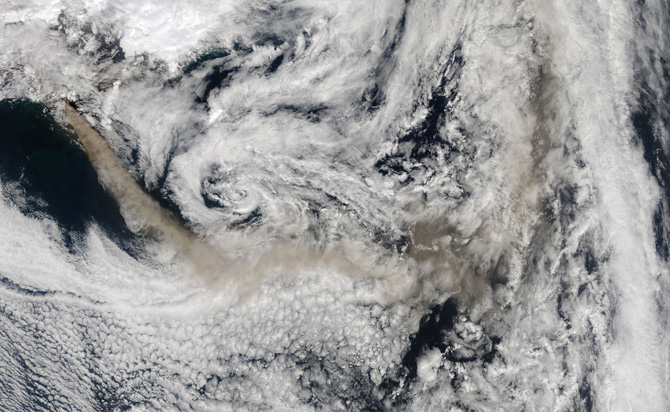
What on Earth was that sound? Was it a bird? A plane? A humpbacked whale?
No, it was fiercely hot gas whooshing through the guts of a volcano — Arenal Volcano in Costa Rica, to be precise. Milton Garces, the director of the Infrasound Laboratory at the University of Hawaii, Manoa, recorded the sound clip we posted last week.
Garces explains the phenomenon this way:
“Much like human voicings are defined by the combination of air flow through the vocal chords, tract, and mouth shapes, this harmonic tremor sound is shaped by the interaction of volcanic gases as they are released and flow through open conduits.”
NASA satellites have got Earth’s volcanoes covered from orbit. They provide round-the-clock monitoring of volcanic eruptions in progress or those possibly on the way. Just two of the satellites used to monitor volcanic activity are Aqua (with its MODIS instrument) and Terra (with its ASTER instrument).
Volcanologists use the satellite data from NASA’s fleet to detect heat and telltale volcanic gases emanating from volcanic vents. Also, Global Positioning System satellite devices allow researchers to gauge subtle changes in the land surface near volcanoes.
And once a volcano pops off, NASA satellites track drifting ash clouds that could threaten aircraft. (You may recall the shenanigans of a certain unpronounceable Icelandic volcano, Eyjafjallajökull, earlier this year.)
As the NASA birds pass silently overhead, Garces clambers up live volcanoes to record their subterranean rumblings. He uses the sounds to diagnose the physical status of volcanic plumbing systems – for example, whether they might be recharging with molten rock (magma) and getting ready to erupt.
These very low frequency waves are called infrasound. In fact, they are too low in their raw form to be audible to humans. So Garces speeds them up artificially to a frequency range the human hearing can detect. Here’s how he explained it to us:
“This signal, which has been sped up by a factor a hundred to make it audible, in reality has a dominant periodicity of about 1 cycle per second (1 Hz). In the field, it sounds like a chugging sound with 1 s puffs, and it is not tonal at all. We lose our sense of tonality at frequencies below around 16 Hz, so infrasound, however harmonious, will be perceived by us more like a beat than a tune.”
In other words, volcano infrasound is pretty interesting to a scientist, but you can’t dance to it — or at least it would be the ultimate slow dance.
— Daniel Pendick, Geeked on Goddard; Eyjafjallajokull image courtesy of NASA Goddard’s MODIS Rapid Response Team

These sort of things always fascinated me.
Nice read.
Jimmy (193020218)
Thanks for the info..
—
Very Interesting. I actually visited this volcano when I was in Costa Rica! For those interested in seeing the eruptions for themselves, I had dinner at the Arenal Observatory Lodge. After dark the eruptions are beautiful. You can hear the the exposions every so often, but no singing obviously!
__________________________________________________________________
Technology
NASA makes such amazing things more accessible to the general public, this post is no exception. The image and audio are amazing!
Thanks,
NASA is a great Space station and aeronautics research. Volcanic gases are very harmful effects to climate with bad gases combination like c02,s02,h2,co,h2s and hcl. It case acid rain also.
__________________________________________________________________
John Guide
NASA is a very wonderful Space station and research/development center. Carbon can be harmful and have negative effects on the climate also.
__________________________________________________________________
TX Electricity
wonderfull article